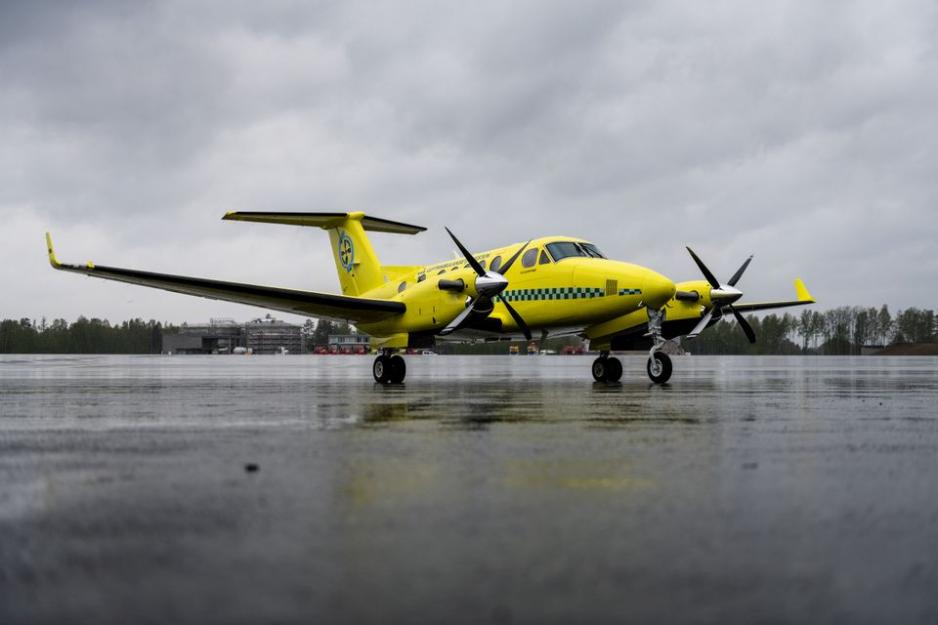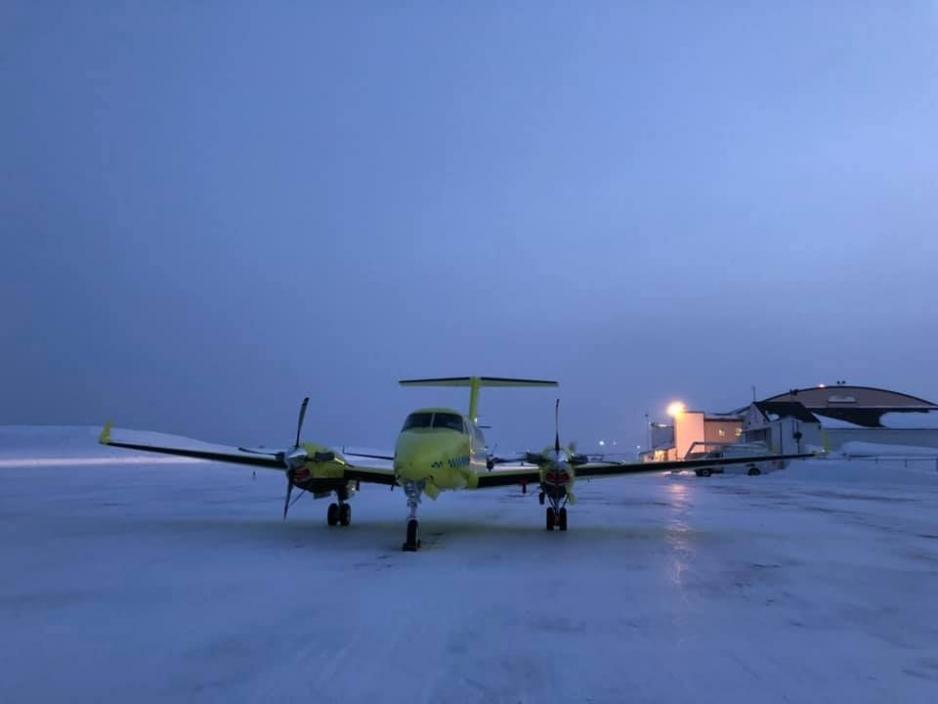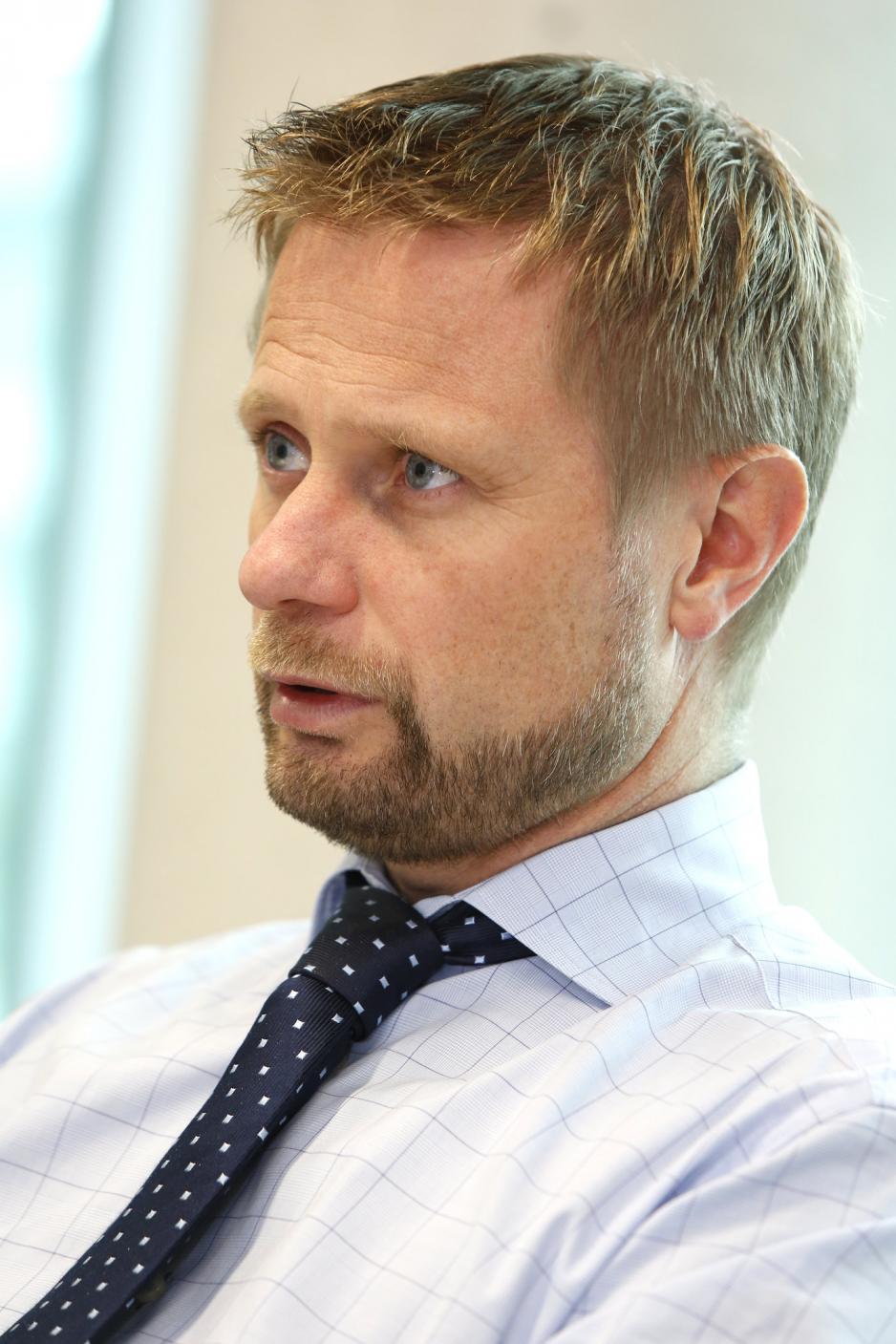Criticism, Campaign and Politics in North Norwegian Air Ambulance Services

Beech B250 ambulance plane. Photo: BSAA
When a foreign company won the tender for supplying air ambulance services in Norway, there was a lot of noise. But how much criticism is actually justified, how much is in reality a campaign, and how much of this is politics?
Norway has one of the world’s, if not the world’s, best public health system. However, a small but critical part of the chain is supplied by a private contractor and subject to privatization and regular tenders: air ambulance services.
Despite this, the service has worked well and not been subject to much criticism.
Until the Norwegian company Lufttransport AS lost the tender to Swedish-British Babcock Air Ambulance in 2018. The contract has a duration of six years and is worth nearly NOK 2.6 billion [appr. € 250 million], with optional continuation of up to five years.
Lufttransport, owned by the Norwegian corporation Ugland, which has operated air ambulance in Norway since 1955 and has had a near-monopoly on this job, lost the tender to an international company following three rounds of tenders and two rounds of negotiations.
The bids from Lufttransport were marginally better when it came to quality, however, they were also NOK 47 million more expensive per annum than its competitor’s offer. In total, the best bid came from Babcock, which was subsequently successful in the competition.
Then all hell broke lose.
Rocky road
The bid from Babcock did not require a formal acquisition of activities [which, according to Norwegian legislation, would have come with formal regulations for transferring employees from one company to the other], which lead a high number of pilots to say they were «not fit for flight», even a year before the new company was to take over. This led to the pilots’ expressing worries about salary levels if and when they were to get a new employer. Some of the Luftransport pilots had an annual salary over NOK 1 million (€ 200,000).
After some time, alleged deviations in the tender process were pointed out too. For instance, price was weighted more than quality in the selection of supplier.
At the same time, news emerged that Bedriftskompetanse AS, the company of then-Chairperson of the board of the regional health authorities Helse Nord, Marianne Telle, was involved in Babcock’s staffing process. As a consequence, Telle withdrew from her chairperson position.
In the bid from Babcock, the company has committed to delivering preparedness to Norway’s population with fewer pilots than its competitor Lufttransport, fewer planes, without its own maintenance base in Norway, and with mandatory maintenance for every 400 flight hours – not every 200 hours, like before.
Note: Today, Babcock has more pilots than Lufttransport had.
On 1 July 2019, Babcock took over operations of the air ambulances in Norway. The company operates from bases in Kirkenes, Alta, Tromsø, Bodø, Brønnøysund, Ålesund and at Gardermoen/Oslo.
91 pilots from Lufttransport transferred to Babcock. And in November, the air ambulance pilot association LTF agreed with Babcock Scandinavian AirAmbulance about a four-year agreement regulating salary and work conditions for the company’s pilots.
So far, so good.
Or perhaps not?
Technical problems
No, not really.
There have been startup problems, however, that was also the case ten years ago when Lufttransport was replacing its planes. It took almost a year into the contract period before Lufttransport had the new planes ready for use. This was despite the same company operating the service up until the time of starting the new contract.
Babcock had all its planes ready for use on 1 July, however, they could barely draw a sigh of relief before new problems appeared.
Early December, news came that five out of 11 Babcock Scandinavian AirAmbulance planes had technical irregularities or weather restrictions that caused them to be withdrawn from service.
As if that was not enough; the five planes that were grounded were all so-called short runway planes; planes that are able to land on the many small airports that are spread out all over Northern Norway.
If you live in Southern Norway, many of the missions the air ambulance take can also be solved rather easily by car ambulances if and when need be. However, if you live in Northern Norway, in particular in Finnmark, the northernmost county, it is not quite that easy. From the two ER’s in Hammerfest and Kirkenes, it is a seven and ten hours’ drive respectively to get to the central hospital UNN in Tromsø.

Beech B250 ambulance plane in winter. Foto: BSAA
Handing in notices
It then emerged that the company had known about the technical challenges as early as in August, however, this information was not made available for the employees until later on.
This caused skepticism and insecurity amongst the pilots. It also spread to doctors and nurses who staff the planes.
A couple of days after news about the technical problems broke, the first air ambulance doctor handed in his resignation as a direct consequence of the situation. “Our new operator is not serious about flight safety and I will not have it. After a couple of months’ flying with a new operator, I find flight security to be such a low priority that I no longer want to be a part of the services. This is out of concern for both myself, my family and children, my friends on the flight crew and the patients we fly”, the air ambulance doctor says in his resignation letter, according to Norwegian broadcaster TV2.
Then one of the nurses asked for leave of absence because she can no longer stand being on duty.
“There is too much insecurity for me. I feel that I have to gamble with security”, says nurse Eija Välikangas to iFinnmark.
Leaked deviation report
The Norwegian health care system is divided into four regional publicly owned health companies that each carries a responsibility for providing for citizens on its territory.
The air ambulance service is jointly owned by all the four health companies, however, Helse Nord – the northern company – carries the responsibility for providing sufficient health services to people in the three northernmost counties as well as Svalbard. Helse Nord is also responsible for four hospitals spread around Northern Norway, and this includes smaller hospitals and nursing clinics that are subject to either of these four.
Not long after news about Babcocks problems broke, a report in which 286 incidents in the air ambulance services have occurred since Babcock took over was leaked. The figures are registered by the emergency central (AMK) in Tromsø, however, the report was released to the media by the hospital in Tromsø (UNN) without its having been previously shared with Babcock.
“We depend on knowing how we can improve. Then all we learn is that there have been 286 incidents, but now what these were. We do not even know if it is all related to us. We are very skeptical to such a report being released unfiltered by UNN”, said Operating Manager Hilde Sjurelv of Babcock.
Accused of factual errors
Then another report was published, one that referred to “eight unwanted incidents after the air ambulance problems” during only 24 hours. Head of Clinic at UNN, Mads Gilbert, said to Norwegian daily VG that he feared lives would be lost.
The move from UNN also sparked reactions from Helse Nord, owner of UNN.
“Helse Nord has assessed these. With only minor reservations, our assessment is that less than half the incidents can be attributed to Babcock’s challenges with air ambulance preparedness”, Helse Nord wrote in a press statement.
One of the Helse Nord directors followed up in an interview with Tromsø daily Nordlys and said: “What UNN writes in its report are factual errors.”
The Director of UNN did not appreciate this and interpreted the statement as a Helse Nord discrediting of the report.
Propaganda war
Norwegian medical daily Dagens Medisin has interviewed politicians who argue that much of the noise stems from the way in which the parties communicate.
In the example mentioned above, the word “deviation” was first used about all 286 incidents, which was later corrected. In health services, the term ‘deviation’ is used about a serious unwanted incident that has or could have had consequences for the patient, while less serious incidents can be registered as part of quality improvement work.
Another example is the press release from Babcock that has the headline “Nine out of nine planes are operative”, while the text further down says that several of them have operative limitations that prevents them from being used in strong winds and that there are still planes that are not able to land on the short runway airport network.
“This is ‘new speak’. The message is creative. If people do not know, they would believe that everything is in perfect order. Two of the planes cannot land on short runways”, Agrarian Party politician Kjersti Toppe says to the paper.
Labour Party Ingvild Kjerkol refers to the situation as “nearly a propaganda war”.
Criticism, campaign or politics?
Coming from the outside to supply critical infrastructure to and in Northern Norway is not easy. Babcock has experienced that the hard way. However, how much of this is timely criticism and how much of it is a campaign? And how much of this is really politics with the purpose of bringing the air ambulance back in under the wings of the state again?
Øyvind Juell, Managing Director of the Air Ambulance Services HF [publicly owned company] argues that there is much politics in this case. At least if one is to trust a presentation he has made and given, one that Norway’s largest daily VG has gotten its hands on.
In the presentation, the Director lists losing operators, staff, politicians and the media amongst the challenges related to a new operator of the air ambulance planes.
Babcock is not mentioned on the list of challenges, however, political discussions both locally as well as nationally is listed. “Politics becomes more important than common sense”, Juell writes in his presentation.
This has, of course, sparked reactions. Amongst others, Agrarian Party MP Kjersti Toppe is provoked and says that “Hospitals and preparedness are a political responsibility and they must accept that there is a debate when an emergency committee has to get to work”.
But will an “in-sourcing” of the air ambulance service solve the problems?
In the last whitepaper about emergency preparedness in Norway from 2017, a united committee concluded that “The air ambulance service is exposed to risks, and this interaction is a precondition for a safe conducting of its missions. The committee argues that the question of a potential public running [of operations] should be thoroughly investigated.”
Yet nothing much happened.
Then Swedish-British Babcock entered the stage and beat Norwegian Lufttransport in a bid. The noise around the bidding process led to the government’s establishing a group of experts that is to present a report in 2020 about how air ambulance services should be operated in the future. Either like it is today, with tenders, or operated by publicly owned or ideal organizations.
Juell held his presentation for this expert group.
Wants urgent processing
Some do not have time to wait for the expert group conclusion.
The Socialist Left Party wants parliament to urgently process a proposal about public authorities taking over the operation of the air ambulance planes.
The Agrarian Party wants “the contract between the air ambulance services and Babcock Scandinavian AirAmbulance to be canceled as a consequence of the company’s not being able to deliver air ambulance preparedness in accordance with the agreement”.
Labour suggests the state should take over operations in a longer term, and that the government should secure preparedness in the High North until that happens.
However, the liberal parties are in majority in Stortinget, the Norwegian parliament, and the proposals were voted down.
“It is only natural that the changing of supplier in such a vital service causes some unrest. Sadly, a good cooperation between the outgoing and the present operators proved impossible to achieve. That made the transition period last longer than scheduled and it caused more unrest. At the same time, opposition politicians have contributed to creating unnecessary worry amongst the population, says State Secretary in the Ministry of Health and Care Services Anne Grethe Erlandsen, in a comment to High North News.
Cancel the contract?
According to Norwegian news agency NTB, Schjødt law firm has written a legal opinion on the Babcock contract and concluded that it is fully possible for the state to cancel it due to all the contract violations that have taken place.
Øyvind Juell, Managing Director of the publicly owned air ambulance company, says the situation in Northern Norway is not currently so dramatic so as to warrant a cancellation of the contract. However, the admits that it may become a possibility.
Whether or not that is possible, however, is an entirely different matter.
Some have even hinted that this has been the goal all the time. Norwegian daily Aftenposten’s op-ed writer Joacim Lund writes, amongst others, that:
“The specialized pilots who worked for Lufttransport had over time accumulated good conditions and had probably hoped for an acquisition of activities in order to not have their salary reduced. They did not get that. They had to apply for jobs that were poorer paid in Babcock, and landing a tariff agreement took a long time. In my head, it is into impossible that some of Babcock’s challenges in having enough people available for shifts may be due to a desire to demonstrate that the service does not work, with the goal of having the contract cancelled.”
Not satisfied with either supplier
All air ambulance planes are currently back to normal operation. However, the extra resources that have been added will be kept as planned until 20 December. Norwegian Health Minister Bent Høie refers to the department’s monitoring the situation closely also after 20 December
At a press conference last Wednesday, the Health Minister stated that “he is not happy with neither Lufttransport deliveries during the past year nor Babcock so far”.
The minister expects preparedness to be supplied in accordance with the agreement hereafter. However, Høie will nevertheless make extra resources available, both during Christmas and later in the winter, “to create peace and stability after such a long period of insecurity”.
An additional plane is placed in Alta, Finnmark as well as a helicopter from the military services in Kirkenes. Work is also ongoing to establishing a permanent ambulance helicopter in Kirkenes, as well as an extra jet plane in Tromsø in order to relieve short runway planes in preparedness, Health Minister Bent Høie said at the press conference.
“Apolgize”
Babcock has not responded to High North News, however, Managing Director Marius Hansen apologizes to VG for the situation with ambulance planes in the High North. However, he says the company has also been criticized for things that are beyond its control:
- The contract the company signed with Luftambulansetjenesten HF was too vague about the change of operators
- Parliament overruled Health Minister Høie and changed the conditions in the middle of the process of taking over operations
- The technical trouble the company has had over the past few weeks
He does not want take a position on the political debate about whether the air ambulance services should be privatized or not:
“We have submitted a tender, it was accepted, we relate to the contract we have signed – and we apologize for not having delivered according to contract. We do not interfere with the ongoing political discussion”, Hansen says to VG.
Facts about the air ambulance service
- Luftambulansetjenesten HF is a publicly owned company holding the responsibility for all air ambulance (planes and helicopters) in Norway.
- The company is owned by the four publicly owned regional health corporations and is headquartered in Bodø.
- All operations of air ambulance in Norway is paid and funded in full by public authorities.
- The regional health companies spend more than NOK 1 bn every year on air ambulances
- The air ambulance is a nationwide service and assists nearly 20,000 patients every year
- The hospitals carry the medical responsibility and staffs the planes and helicopters with nurses and doctors.
- Air, boat and car ambulances are part of the non-hospital emergency medical preparedness services.
- The service has 13 ambulance helicopters in 12 bases and 9 ambulance planes in 7 bases.
- The bases are on-call 24/7 year-round.
- Helicopters primarily take ambulance assignments, however, they also do some search and rescue (SAR).
- The rescue service helicopters, the 330 squadron, also takes some ambulance assignments for the air ambulance services.
This article was originally published in Norwegian and has been translated by HNN's Elisabeth Bergquist.



